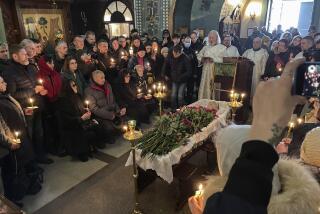Sverdlovsk Shrine to Honor Last Czar : Soviet Union: Church plans a building where Nicholas II was executed.
- Share via
MOSCOW — The Russian Orthodox Church is planning to build a shrine to the “martyrs” of the Bolshevik Revolution on the site where Nicholas II, Russia’s last czar, was executed by the Communists in 1918.
Nikolai P. Kalinin, warden of St. John the Baptist Cathedral in Sverdlovsk, said Tuesday that a large chapel will be built and regular services held to honor Nicholas, his family and servants, and other “martyrs unjustly executed” in the past seven decades of Communist rule.
The project reflects both the growing role, encouraged by President Mikhail S. Gorbachev and other Soviet leaders, that the Russian Orthodox Church is playing in the country’s life and the re-evaluation of virtually everything that the Communist Party has done, including the revolution that brought it to power.
As the revolution is reassessed, however, Nicholas II is emerging as almost a cult figure, a symbol of the past greatness of imperial Russia, as many here seek to forget the past seven decades as simply a wrong turn that the country made or maybe a bad dream that has lasted three generations.
The czar’s picture was carried in a Russian Orthodox procession through central Moscow last month when two important churches were reconsecrated for religious use. Many Orthodox priests and church members want the czar canonized as a saint and martyr.
Regional authorities gave the site to the church last month after demands by local political groups and thousands of city residents that the czar be properly commemorated, Kalinin said.
Nicholas II’s death is the subject of a popular play in Moscow, a new biography is being published about him, he is featured in two ballads often heard on the radio and three movie scripts about his life and death are competing for approval for filming.
The czar was shot in the cellar of the home of a rich merchant named Ipatiev in Ekaterinburg, later renamed Sverdlovsk, on the evening of July 16, 1918, along with his wife, Czarina Alexandra; their son, Alexei, the heir to the throne, and four daughters. Four servants were also killed.
Their bodies were never found. Most historians have accepted the accounts of those who said they were involved in the execution and who told of burning the bodies and scattering the bones in a mine shaft. Last year, however, a writer claimed that he had found the czar’s skull and other bones and asserted that the bodies had been doused with acid and buried in a swamp.
The execution was carried out by members of the Cheka, the security police, to prevent anti-Communist White Russian forces from rescuing the czar and restoring him to the throne. Nicholas II had been forced to abdicate in March, 1917, at the start of the upheaval that later brought the Bolsheviks to power. He and his family were moved from place to place until they ended up in Ekaterinburg, 1,050 miles east of Moscow in the eastern foothills of the Ural Mountains.
The Ipatiev house became a place of pilgrimage over the years, and the late President Leonid I. Brezhnev ordered its destruction in the 1970s. Boris N. Yeltsin, now president of the Russian Federation, the country’s largest republic, but then the Sverdlovsk party leader, has said that he twice ignored the orders, but finally in 1977 he sent bulldozers to demolish the house.
More to Read
Sign up for Essential California
The most important California stories and recommendations in your inbox every morning.
You may occasionally receive promotional content from the Los Angeles Times.













